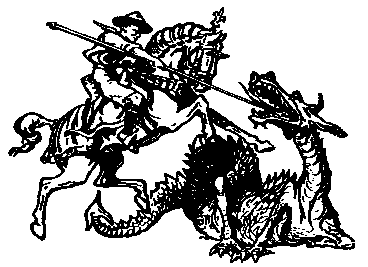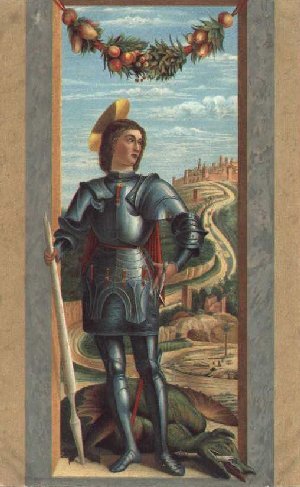Saint George, Martyr
Optional Memorial
April 23rd

Greek - Icon
16th Century from personal collection
O God, Who dost gladden us by the merits and intercesion of Blessed George, Thy Martyr, mercifully grant that we, who ask Thy blessings through him, may obtain them by the gift of Thy grace. Through our Lord Jesus Christ, Thy Son, Who liveth and reigneth with Thee in Unity of the Holy Spirit, God, world without end. Amen.
(Prayer from Saint Joseph Missal, 1950, Catholic Book Publishing)
Collect:
Lord,
hear the prayers of those who praise Your mighty power.
As Saint George was ready to follow Christ in suffernig and death,
so may he be ready to help us in our weakness.
We ask this through our Lord Jesus Christ, Your Son,
who lives and reigns with You and the Holy Spirit,
one God, for ever and ever. +Amen.
Readings of the Day:
First Reading - Revelation 21:5-7
And He who sat upon the throne said, "Behold, I make all things new." Also He said, "Write this, for these words are trustworthy and true." And He said to me,"It is done! I am the Alpha and Omega, the beginning and the end. To the thirsty I will give water without price from the fountain of the water of life. He who conquers shall have this heritage, and I will be his God and he shall be My son."
Gospel Reading - Luke 9:23-26
And He[Jesus] said to all, "If any man would come after Me, let him deny himself and take up his cross daily and follow Me. For whoever would save his life will lose it; and whoever loses his life for My sake, he will save it. For what does it profit a man if he gains the whole world and loses or forfeits himself? For whoever is ashamed of Me and of My words, of him will the Son of man be ashamed when He comes in His glory and the glory of the Father and of the holy angels.
[Scripture translation - Revised Standard Version: Catholic Edition]
Saint George, A Patron of Chivalry
by Joanna Bogle
We need a patron of chivalry, a hero saint who will show us an example of how to defend the Church, protect the poor and vulnerable, and meet martyrdom with courage. In these days when being an active and committed Catholic means standing against many of the everyday ideas and assumptions prevalent in our communities, we need a champion of personal valour, of standing up to be counted, a person who will show us what it is to exert true Christian leadership.
Enter Saint George. He was a soldier in the early years of the 4th century, serving in the Roman Army. His ruler was the Emperor Diocletian. George was a Tribune -- a rank about equivalent to today's Colonel. He was also a Christian, and, for several years, this apparently posed no problem. At this point there were several Christian communities within the Roman world. Christians were beginning to make their influence felt and as they were good citizens, honest, trustworthy, and loyal, they were more than tolerated by the Empires rulers.
But Diocletian grew envious. Where once he had been content with the loyalty of his subjects in temporal matters, now he wanted more. He sought the loyalty of their minds and souls. When this was not forthcoming, he grew savage. An edict against Christians was drawn up and copies posted in public places. George, as a leading citizen, took responsibility for tearing down the one in his locality -- an open act of defiance against an unjust law. He was arrested, tortured, and eventually martyred. He died on April 23rd, 404, which that year happened to be Good Friday. It is said that red roses bloomed on his grave.
All these events took place in the territory we today call the Middle East, then part of the Roman Empire. The story of George's valor spread across the Christian world. We know that there were churches in Europe dedicated to him at an early date, including a couple in Britain, the land where he was later to become a popular saint. But what really made him famous were the events of several centuries later -- the Crusades. English soldiers fighting in the Middle East learned about this soldier-saint and were impressed. His courage spoke to them. He was one of their own. This was a saint they could value and understand.
They took back his story to England -- as other soldiers were taking it back to their lands across what was then Christendom. His story became identified with their own -- the red cross on a white background that marked the crusader.
In England, Saint George became patron saint of an order of chivalry -- the Order of the Garter. To this day, this is still conferred by the Sovereign in honor of God, Our Lady, and Saint George on those deemed to have served their country in some outstanding way.
Catholics in England have long honored Saint George. As with other saints, he was somewhat downplayed at the Reformation. But English Catholics continued to honor him. They were persecuted for their faith for years after the Reformation and unable to attend Mass openly or teach their Faith publicly to their children. No wonder a hero martyr saint appealed to them.
When, finally, some freedom was granted, one of the first Catholic churches to be built in London was dedicated to Saint George. Today, its successor still stands in Southwark, on the south bank of the Thames -- Saint George's Cathedral. It has seen many major events -- from a tragic bombing in 1941, which destroyed the original Pugin building (the cathedral was rebuilt in the 1950s) to a Papal visit in 1982 when Pope John Paul II met and blessed thousands of sick people who had been gathered there to greet him in a massive national pilgrimage.
Saint George's continues to thrive: it now serves a very multi-racial area, and its liturgy includes a robed choir who sing a beautiful Latin Mass each Sunday, which is well attended by a mixed congregation proud of their church and of their Faith.
This year, a team of Catholic publishers and representatives from major Catholic organizations from across Britain will be holding a national Catholic Book Fair on the Saturday nearest to Saint George's Day as part of the Saint George's Day celebrations.
We need Saint George today. We need his example of courage. Legend says he slew a dragon -- or, in some versions of the story, that he tamed it and brought it to the service of the Christian community. In this latter version, the dragon is seen as the pagan Roman Empire, which eventually came to be subdued by the Church.
Saint George was a manly saint -- a hero, a soldier, someone who knew he must use his strength and courage in the service of what is right. A martyr's life is a paradox: through death he brings life to the Church. What seems to be a failure ends in glory. Because of Saint George's sacrifice, the Faith survived to be passed on to countless people in lands he never even knew existed. If we met him today -- if our young Christian men, who so badly need heroes, met him -- we would know that we shared the same Catholic Faith and in the Sign of the Cross we would be in unity. May we beg through his intercession in Heaven that we may have something of his courage.
Saint George, pray for us!
from A Book of Feasts and Seasons, by Joanna Bogle
Saint George's Day - How to set the table
Use a white sheet as a tablecloth. Across it stretch two lengths of crimson ribbon to form a Saint George's Cross. The ends of the ribbon should be cut into inverted V's -- this looks neat and helps prevent fraying. The ribbon can be pinned to the cloth -- this keeps the arrangement looking nice all through the meal and it is quite easy to do it in such a way that the pins don't show. A red rose -- you can now buy very attractive linen or silk ones at very little cost -- should be placed at the center of the cross. Use red candles.
Saint George's Day - Trifle for Saint George's Day
Serves six -- multiply the amounts as needed.
a dozen sponge fingers
six tablespoons raspberry jam
one packet of raspberry jelly
one tin raspberries
one pint custard
sherry
half a pint whipped cream
glacé cherries to decorate
Make up the custard first and allow it to get cold. Make up the raspberry jelly as directed on the packet, but use ice cubes instead of cold water as this makes it set far more quickly. It more or less sets as the ice cubes melt. Spread the sponge fingers with jam and put them in a large glass bowl. Pour sherry generously over them. Drain the raspberries and put these on top. Pour the jelly over these and leave it all to set. Then add the custard on top. Decorate the top of the trifle by covering it thickly with whipped cream and putting cherries on it. Do not add any other decorations: the theme for St. George's Day is Red and white. A wide velvet ribbon tied around the bowl looks nice.
Joanna Bogle is a Catholic writer and journalist living in London. She is a member of the Women for Faith and Family Editorial Board. Joanna broadcasts with the BBC and with Mother Angelica's EWTN radio, on which she has a "Catholic Heritage" series featuring places of pilgrimage and of historic interest in Europe. She is active with the Association of Catholic Women and with pro-life movements in Britain.






